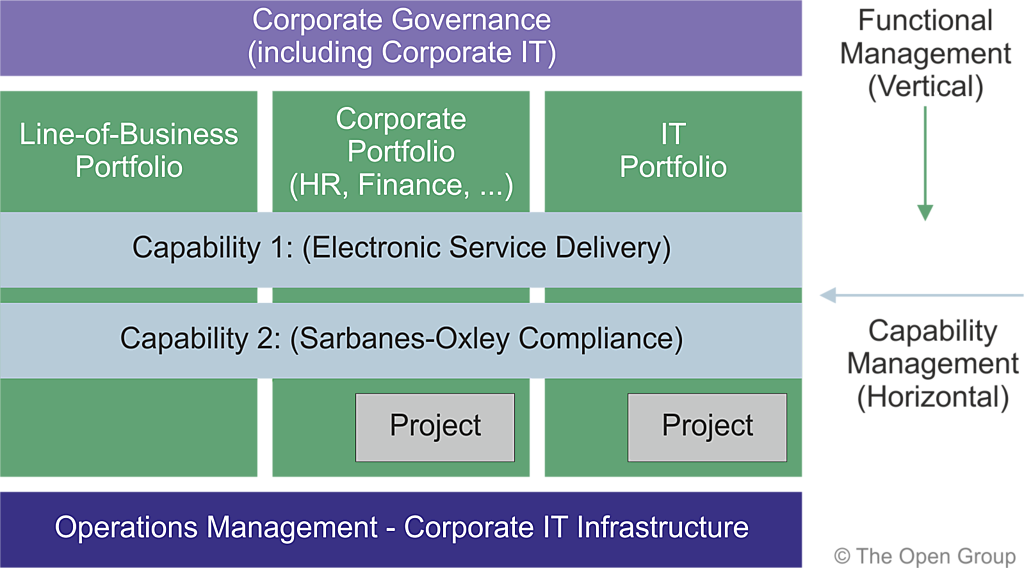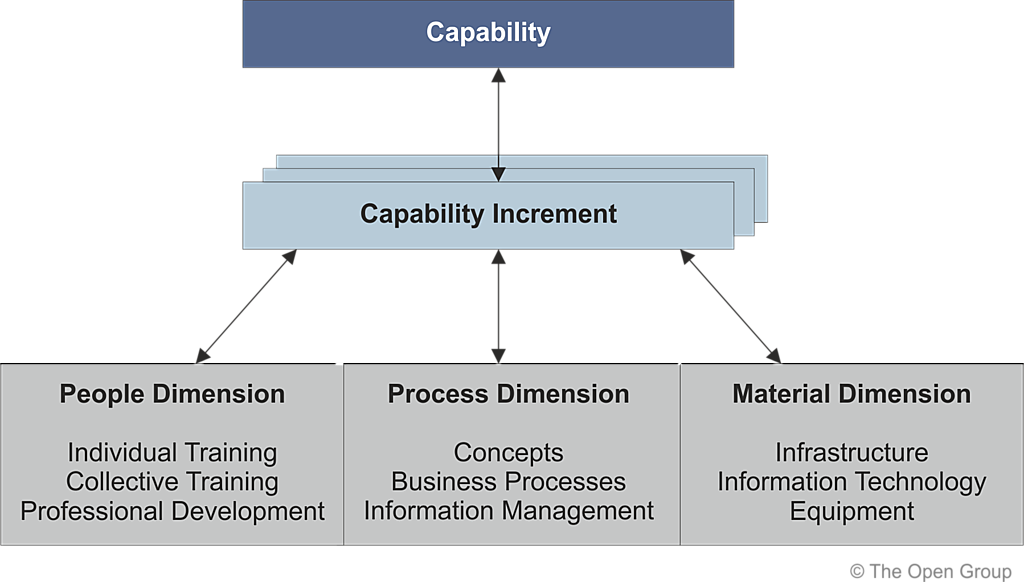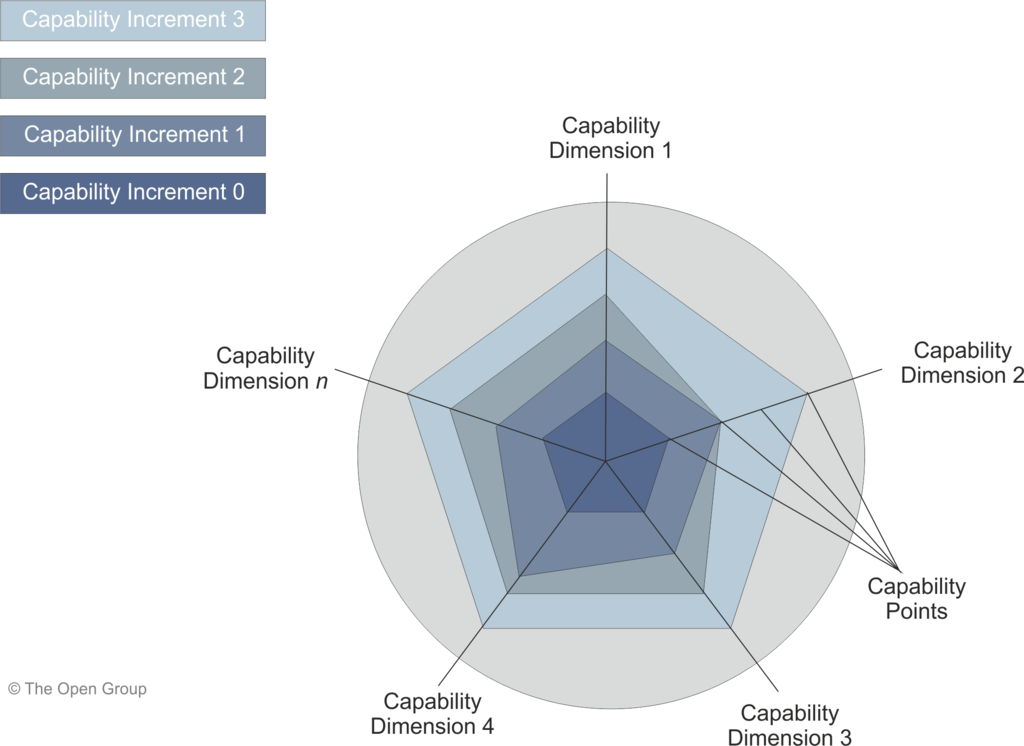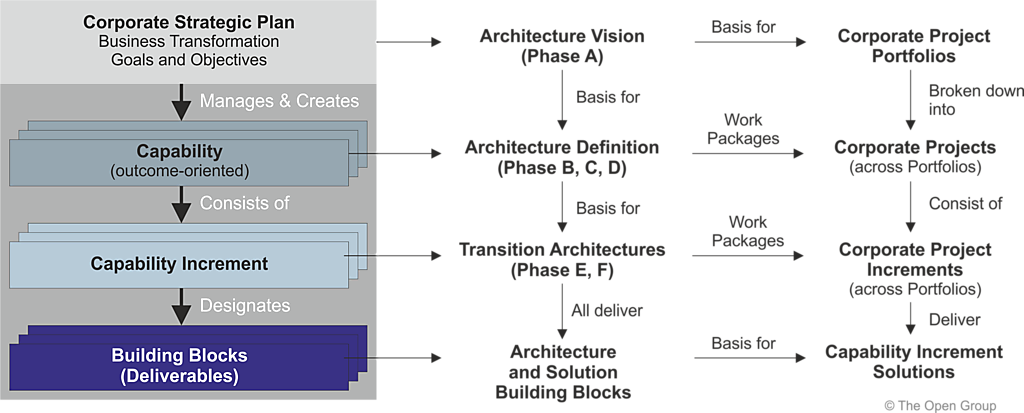
| You are here: | ||
| <<< Previous | Home | Next >>> |
This chapter provides an overview of capability-based planning, a business planning technique that focuses on business outcomes. It also copes well with the friction of co-ordinating projects across corporate functional domains that together enable the enterprise to achieve that capability (for example, electronic service delivery).
Capability-based planning focuses on the planning, engineering, and delivery of strategic business capabilities to the enterprise. It is business-driven and business-led and combines the requisite efforts of all lines of business to achieve the desired capability. Capability-based planning accommodates most, if not all, of the corporate business models and is especially useful in organizations where a latent capability to respond (e.g., an emergency preparedness unit) is required and the same resources are involved in multiple capabilities. Often the need for these capabilities are discovered and refined using business scenarios (see the TOGAF® Series Guide: Business Scenarios).
From an IT perspective, capability-based planning is particularly relevant. For example, setting up a data center is really about consolidating corporate data and providing the related services. Lead Enterprise Architects for this capability will find themselves involved in managing construction, personnel training, and other change management tasks as well as IT architecture tasks. In the past, many IT projects were less than successful even though the actual IT implementation was brilliant, but the associated other tasks (business process re-engineering, client training, support training, infrastructure, and so on) were not controlled by the Enterprise Architects and planners and often were not satisfactorily completed.
On the other hand, IT projects were often described in terms of technical deliverables not as business outcomes, making it difficult for business to appreciate what was being delivered and often the IT architects lost sight of the ultimate business goal. Capability-based planning frames all phases of the architecture development in the context of business outcomes, clearly linking the IT vision, architectures (ABBs and SBBs), and the Implementation and Migration Plans with the corporate strategic, business, and line-of-business plans.
In many governments, horizontal interoperability and shared services are emerging as cornerstones of their e-Government implementations and capability-based management is also prominent although under many guises. In the private sector, the concepts of supply chain management and Service-Oriented Architecture (SOA) are increasingly forcing planners/managers to govern horizontally as well as vertically.
Capability-based planning has long been entrenched in the Defense realm in the US, UK, Australia, and Canada. The associated governance mechanisms, as well as rigorous capability derivation (capability engineering), are emerging primarily in the systems engineering domain. These concepts are readily transferable into other domains, such as IT.
From an Enterprise Architecture and IT perspective, capability-based planning is a powerful mechanism to ensure that the strategic business plan drives the enterprise from a top-down approach. It is also adaptable with capability engineering to leverage emerging bottom-up innovations.
No matter how the corporation structures itself, it will have to cope with the delivery of business capabilities whose delivery will require co-ordination and alignment across business verticals.
Capabilities are business-driven and ideally business-led. One of the main challenges is that the benefits are often reaped at the enterprise and not the line-of-business level. Consequently, projects within line-of-business-led portfolios tend to take a line-of-business rather than corporate perspective. Managing the delivery of a capability is challenging, but the entrenchment of a capability-based perspective within an organization is a powerful mechanism to deliver synergistically derived business value that will resonate in profitability and stock value.
Capabilities should be specified using the same discipline in the specification of objectives as in business scenarios; specifically, they should follow the SMART guidelines to avoid ambiguity.
As shown in Figure 28-1 , many capabilities are "horizontal" and go against the grain of normal vertical corporate governance. Most often, management direction as well as the corporate management accountability framework are based upon line of business metrics, not enterprise metrics. Enterprise Architecture is also a horizontal function that looks at enterprise-level (as well as line of business-level) optimization and service delivery. Not surprisingly, capability-based planning and Enterprise Architecture are mutually supportive. Both often operate against the corporate grain and both have to cope with challenging business environments. Business support of Enterprise Architecture is crucial for its success and it is logical that it aligns with the corporate capability planners as well as providing support for those within the vertical lines of business.

Capabilities can also be vertical and handled in the context of the business organizational structure. In fact, capability requirements often drive organizational design, but within an organization in the process of business transformation, the organization may be trailing the capability needs.
Vertical capabilities are easier to handle and support by the Enterprise Architecture function, but still challenging when services are rationalized at the enterprise level and lines of business receive shared services that they do not directly control (they provide indirect control through IT governance in the Architecture Board as created in preliminary planning and used in Phase G (Implementation Governance).
For capability-based planning to succeed, it has to be managed with respect to dimensions and increments, as explained in the following two sections.
Capabilities are engineered/generated taking into consideration various dimensions that straddle the corporate functional portfolios.
Every organization has a different but similar set of dimensions. An example set (based upon the Canadian Department of National Defense) could include personnel, research & development, infrastructure/facilities, concepts/processes, information management, and material. Whatever dimensions are selected, they should be well explained and understood.

A capability will take an extended time to deliver (specifics will be a function of the organization and industry vertical) and will normally involve many projects delivering numerous increments. In addition, the capability needs to provide real business value to stakeholders as soon as possible and maintain momentum to achieve the Target Architecture as well as the associated executive support and corporate funding. Therefore, it is useful to break the capability into capability increments that deliver discrete, visible, and quantifiable outcomes as well as providing the focus for Transition Architectures and the deliverables from numerous inter-dependent projects. These outcomes are the Critical Success Factors (CSFs) for continued capability support.
Communicating the potentially complex incremental evolution of a capability to the stakeholder community is essential to establish buy-in at the start and to maintain their buy-in during the transition. The Capability Increment "Radar" diagram (see Figure 28-3) is a proven approach to describing how a capability will evolve over time. The architect selects the aspects of capability that are important to the stakeholder community as lines radiating from the center. Against each line, the architect draws points that represent significant "capability points" ("lower" capability points nearest the center; "higher" capability points farthest from the center). With these "markers" in place the architect can, by joining up the capability points into a closed loop, demonstrate in a simple form how each "capability increment" will extend on the previous increment. This, of course, requires that each capability point is formally defined and "labeled" in a way that is meaningful to the stakeholders. In Figure 28-3 , we have depicted Capability Increment 0 as the starting capability.

The capabilities are directly derived from the corporate strategic plan by the corporate strategic planners that are and/or include the Enterprise Architects and satisfy the enterprise goals, objectives, and strategies. Most organizations will also have an annual business plan that describes how the organization intends to proceed over the next fiscal period in order to meet the enterprise strategic goals.
Figure 28-4 illustrates the crucial relationships between capability-based planning, Enterprise Architecture, and project/portfolio management. On the left-hand side, capability management is aligned with Enterprise Architecture. The key is that all of the architectures will be expressed in terms of business outcomes and value rather than in IT terms (e.g., establishment of a server farm), thereby ensuring IT alignment with the business.
The intent is that the corporate strategic direction drives the Architecture Vision in Phase A, as well as the corporate organization which will be the basis for the creation of portfolios.
Specific capabilities targeted for completion will be the focus of the Architecture Definition (Phases B, C, and D) and, based upon the identified work packages, Phase E projects will be conceived.
The capability increments will be the drivers for the Transition Architectures (Phase E) that will structure the project increments. The actual delivery will be co-ordinated through the Implementation and Migration Plans (Phase F).

Capability managers will perform similar tasks to that of the portfolio managers, but across the portfolios aligning the projects and project increments to deliver continuous business value. Whereas the portfolio managers will be concerned with the co-ordination of their projects to optimally design, build, and deliver the Solution Building Blocks (SBBs). Ideally, capability managers will also manage funding that can use the Transition Architectures as gates. Co-ordination between the portfolio and capability managers will have to be provided at the corporate level.
Capability-based planning is a versatile business planning paradigm that is very useful from an Enterprise Architecture
perspective. It assists in aligning IT with the business and helps focus IT architects on the continuous creation of business
value.
 return to top of page
return to top of page